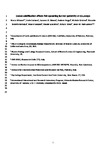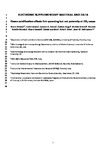Ocean acidification affects fish spawning but not paternity at CO2 seeps
| dc.contributor.author | Milazzo, M | |
| dc.contributor.author | Cattano, C | |
| dc.contributor.author | Alonzo, SH | |
| dc.contributor.author | Foggo, Andrew | |
| dc.contributor.author | Gristina, M | |
| dc.contributor.author | Rodolfo-Metalpa, R | |
| dc.contributor.author | Sinopoli, M | |
| dc.contributor.author | Spatafora, D | |
| dc.contributor.author | Stiver, KA | |
| dc.contributor.author | Hall-Spencer, Jason | |
| dc.date.accessioned | 2016-08-25T13:17:59Z | |
| dc.date.issued | 2016-07-27 | |
| dc.identifier.issn | 0962-8452 | |
| dc.identifier.issn | 1471-2954 | |
| dc.identifier.other | 20161021 | |
| dc.identifier.uri | http://hdl.handle.net/10026.1/5379 | |
| dc.description.abstract |
<jats:p> Fish exhibit impaired sensory function and altered behaviour at levels of ocean acidification expected to occur owing to anthropogenic carbon dioxide emissions during this century. We provide the first evidence of the effects of ocean acidification on reproductive behaviour of fish in the wild. Satellite and sneaker male ocellated wrasse ( <jats:italic>Symphodus ocellatus</jats:italic> ) compete to fertilize eggs guarded by dominant nesting males. Key mating behaviours such as dominant male courtship and nest defence did not differ between sites with ambient versus elevated CO <jats:sub>2</jats:sub> concentrations. Dominant males did, however, experience significantly lower rates of pair spawning at elevated CO <jats:sub>2</jats:sub> levels. Despite the higher risk of sperm competition found at elevated CO <jats:sub>2</jats:sub> , we also found a trend of lower satellite and sneaker male paternity at elevated CO <jats:sub>2</jats:sub> . Given the importance of fish for food security and ecosystem stability, this study highlights the need for targeted research into the effects of rising CO <jats:sub>2</jats:sub> levels on patterns of reproduction in wild fish. </jats:p> | |
| dc.format.extent | 0-0 | |
| dc.format.medium | ||
| dc.language | en | |
| dc.language.iso | en | |
| dc.publisher | The Royal Society | |
| dc.subject | pH | |
| dc.subject | CO2 vent | |
| dc.subject | alternative reproductive tactics | |
| dc.subject | Labrid | |
| dc.subject | climate change | |
| dc.title | Ocean acidification affects fish spawning but not paternity at CO2 seeps | |
| dc.type | journal-article | |
| dc.type | Journal Article | |
| plymouth.author-url | https://www.webofscience.com/api/gateway?GWVersion=2&SrcApp=PARTNER_APP&SrcAuth=LinksAMR&KeyUT=WOS:000382430800014&DestLinkType=FullRecord&DestApp=ALL_WOS&UsrCustomerID=11bb513d99f797142bcfeffcc58ea008 | |
| plymouth.issue | 1835 | |
| plymouth.volume | 283 | |
| plymouth.publication-status | Published | |
| plymouth.journal | Proceedings of the Royal Society B: Biological Sciences | |
| dc.identifier.doi | 10.1098/rspb.2016.1021 | |
| plymouth.organisational-group | /Plymouth | |
| plymouth.organisational-group | /Plymouth/Faculty of Science and Engineering | |
| plymouth.organisational-group | /Plymouth/Faculty of Science and Engineering/School of Biological and Marine Sciences | |
| plymouth.organisational-group | /Plymouth/PRIMaRE Publications | |
| plymouth.organisational-group | /Plymouth/REF 2021 Researchers by UoA | |
| plymouth.organisational-group | /Plymouth/REF 2021 Researchers by UoA/UoA07 Earth Systems and Environmental Sciences | |
| plymouth.organisational-group | /Plymouth/Research Groups | |
| plymouth.organisational-group | /Plymouth/Research Groups/Marine Institute | |
| plymouth.organisational-group | /Plymouth/Users by role | |
| plymouth.organisational-group | /Plymouth/Users by role/Academics | |
| dc.publisher.place | England | |
| dcterms.dateAccepted | 2016-06-29 | |
| dc.rights.embargodate | 2017-7-27 | |
| dc.identifier.eissn | 1471-2954 | |
| dc.rights.embargoperiod | 12 months | |
| rioxxterms.versionofrecord | 10.1098/rspb.2016.1021 | |
| rioxxterms.licenseref.uri | http://www.rioxx.net/licenses/under-embargo-all-rights-reserved | |
| rioxxterms.licenseref.startdate | 2016-07-27 | |
| rioxxterms.type | Journal Article/Review |



